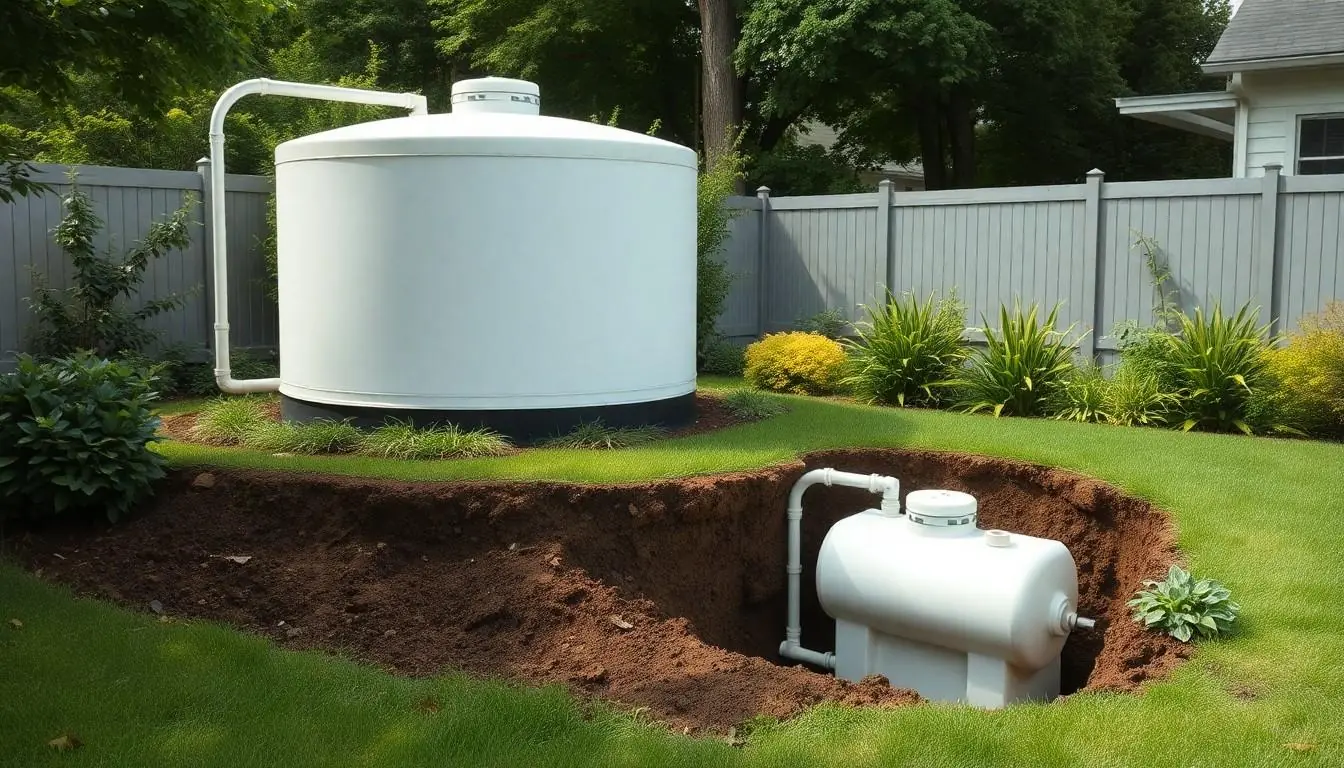Imagine a world where you never run out of gas for your grill during a backyard barbecue or find yourself scrambling for fuel during a winter storm. A gas storage tank for home can turn that dream into reality. Not only does it provide a reliable source of energy, but it also offers peace of mind knowing you’re prepared for anything life throws your way.
With the right gas storage tank, homeowners can enjoy convenience and efficiency without the hassle of frequent trips to the gas station. Plus, who wouldn’t want to impress their neighbors with a well-stocked gas supply? It’s time to elevate your home’s energy game and unlock the benefits of having your own gas storage solution. Let’s dive into why a gas storage tank might just be the unsung hero of your household.
Table of Contents
ToggleOverview of Gas Storage Tanks for Home
Gas storage tanks provide homeowners with a practical solution for energy needs. These tanks can supply fuel for generators, heating, and cooking. During emergencies like winter storms, a stocked tank ensures access to necessary energy. Various sizes of tanks suit different household needs and available spaces.
Installation options include outdoor and indoor setups. Outdoor tanks require proper placement to ensure safety and compliance with local regulations. Indoor tanks offer convenience but must adhere to strict safety guidelines. Homeowners must choose the type that best aligns with their living situation.
Regular maintenance is essential for gas storage tanks. Inspections help identify leaks or damages, ensuring safe operation. Homeowners should schedule routine check-ups to maintain efficiency and safety. Manufacturers often provide specific maintenance recommendations.
Cost considerations include initial purchase, installation, and ongoing maintenance expenses. Small tanks typically cost between $200 and $1,500, while larger tanks can exceed $5,000. Insurance may also factor into overall costs, as some policies provide coverage for gas storage equipment.
Understanding local regulations impacts planning for a gas storage tank. Zoning laws and safety codes vary by region and may dictate tank placement and installation methods. Homeowners need to consult local authorities before proceeding with installation.
Gas storage tanks offer reliability and efficiency for home energy solutions. Essential features for homeowners include proper maintenance, cost evaluations, and compliance with regulations. Considering these factors leads to informed decisions regarding gas storage options for the household.
Types of Gas Storage Tanks

Gas storage tanks come in various forms, primarily classified as above ground and below ground tanks. Each type offers unique benefits and considerations for homeowners.
Above Ground Tanks
Above ground tanks showcase accessibility and ease of installation. Common materials include steel and fiberglass, providing durability and resistance to wear. These tanks typically sit on a sturdy base, ensuring stability and protection from environmental factors. Maintenance checks become more straightforward since visibility and access are enhanced. Above ground tanks usually range from 100 to 1,000 gallons, catering to different energy needs. Local regulations often dictate placement and safety measures, so homeowners should verify compliance with relevant codes.
Below Ground Tanks
Below ground tanks offer discreet storage solutions, effectively conserving yard space. They require excavation, thus necessitating careful installation and adherence to safety standards. These tanks are often made of corrosion-resistant materials to enhance longevity. A common size for residential options is between 500 and 1,000 gallons, allowing for substantial gas capacity. Proper ventilation remains critical for safety, as does routine monitoring for leaks or other issues. Local zoning laws significantly influence tank placement and installation processes, making it essential to consult local authorities before proceeding.
Benefits of Having a Gas Storage Tank at Home
Gas storage tanks provide numerous advantages for homeowners. These advantages enhance convenience and efficiency in everyday life.
Cost Efficiency
Cost savings arise from using a gas storage tank. Homeowners avoid frequent trips to gas stations. Bulk purchasing reduces fuel costs, often leading to lower overall expenses. Small tanks typically range from $200 to $1,500, while larger units exceed $5,000. While initial costs are a consideration, the long-term savings on fuel and energy bills can offset the investment significantly. With a readily available fuel supply, gas prices during emergencies or price surges become less impactful.
Energy Independence
Energy independence significantly enhances a household’s resilience. A gas storage tank allows homeowners to generate power, heat, and cook without relying solely on the grid. During power outages or severe weather, the tank proves invaluable. Access to fuel during emergencies eliminates worries about utility disruptions. Homeowners gain confidence knowing they can manage their energy needs effectively. This control fosters peace of mind, positioning gas storage tanks as critical components of modern home energy solutions.
Safety Considerations
Safety remains a top priority when installing and using gas storage tanks at home. Understanding and adhering to regulations ensures safe operation and risk mitigation.
Regulations and Compliance
Local regulations dictate the installation and usage of gas storage tanks. Homeowners must check zoning laws, which govern tank placement and size. Compliance with local fire codes ensures safe operation and minimizes hazards. In many areas, permits are required before installing a gas storage tank. Following these guidelines helps prevent fines and safety breaches. Typically, safety codes also dictate tank materials and recommended distances from structures and property lines.
Maintenance Tips
Routine maintenance plays a crucial role in keeping gas storage tanks safe. Inspect tanks regularly for leaks or corrosion. Homeowners should check valves and connections, ensuring they function properly. Cleaning the exterior prevents buildup that can hide signs of wear. Testing pressure levels helps identify potential issues before they escalate. Additionally, it is important to maintain proper ventilation around tanks. Keeping the area clear of debris and flammable materials is essential for preventing accidents. Regular maintenance not only ensures safety but also enhances the longevity of the tank.
Installation Process
Understanding the installation process for a gas storage tank ensures safety and compliance. First, homeowners must check local zoning laws to determine permitted tank sizes and placements. Choosing the right location for the tank significantly impacts accessibility and usability.
Professional assistance often simplifies the installation. Contractors with specific experience in gas tank setups can handle regulatory requirements and safety codes. They provide insights into the most efficient installation options, whether above ground or below ground. Notably, above ground tanks facilitate easier access for maintenance, while below ground options conserve yard space.
Proper ventilation is crucial for minimizing risks. Open spaces around tanks help prevent hazardous gas accumulation. Homeowners must secure necessary permits before the installation takes place, as skipping this step can lead to fines or unsafe conditions.
Installation typically involves excavation if opting for below ground models. Professionals ensure tanks are placed at safe depths, reducing environmental hazards. In contrast, above ground tanks require stable foundations to support their weight and secure positioning.
After installation, regular inspections are vital to maintain tank integrity. Homeowners should monitor for leaks, corrosion, or issues with valves and connections regularly. Routine cleaning also enhances safety and operational efficiency.
Finally, partnering with local authorities ensures adherence to safety regulations post-installation. Following these guidelines safeguards both the homeowner and the community from potential risks associated with gas storage tanks.
Investing in a gas storage tank can significantly enhance a homeowner’s energy independence and convenience. With the ability to power essential appliances during emergencies and reduce trips to the gas station, it’s a practical solution for many households.
Prioritizing safety and adhering to local regulations ensures that the installation process goes smoothly and safely. Regular maintenance and inspections further guarantee the tank operates efficiently.
Ultimately, a gas storage tank represents a smart investment that not only provides immediate benefits but also contributes to long-term savings and peace of mind. Homeowners who consider this option are likely to enjoy greater control over their energy needs while enhancing their home’s overall resilience.


